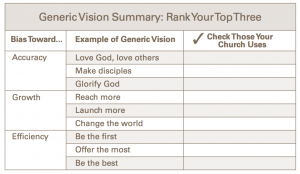Are you a visionary but just not sure the vision is connecting?
Imagine that the role of vision in your church is like an axe. When skillfully used, it makes a path clear. It removes obstacles. It broadens the path for others to follow. It enables greater accomplishment.
Most pastors regularly pick up the axe of vision in their ministry. Some quickly set it back down, having never been trained in its effective use. Others swing like crazy, unaware that they wield a dull edge. Too often they become frustrated or confused by too little return for their tireless work.
Solution – Recognize your generic vision
THE QUICK SUMMARY – God Dreams by Will Mancini
Is your team excited about the next big dream for your church?
You are a visionary leader and your church probably has a vision statement. Yet most churches are stuck in a trap of generic communication without a truly visionary plan. Just like a visionary restaurant needs a more specific focus than “serving food,” a visionary church needs something more than biblical generalizations like “loving God, loving people” or “making disciples and serving the world.”
When a team doesn’t share an understanding of God’s next big dream, leadership grows tired, overworked by an “all things to all people” ministry approach. Too often there’s no unified picture of what success looks like. People can feel uninspired and your church’s programming can seem more optional than ever.
Ministry without clarity is insanity. Are you ready for a better way?
In this groundbreaking work, based on Will Mancini’s 15 years and over 10,000 hours of church team facilitation, God Dreams reveals a simple and powerful planning method that will bring energy and focus to your church like never before.
First, God Dreams shows how to reclaim the role of long-range vision today by providing 12 vision templates, each with biblical, historical, and contemporary illustrations. These vision starters will dramatically accelerate your team’s ability to find complete agreement regarding your church’s future.
Second, God Dreams explains how to overcome the fruitless planning efforts that many church teams experience. With a tool called the Horizon Storyline, leaders can connect short-term action steps with the long-range dream, while leveraging the power of storytelling to make the plan “stick.” This tool will galvanize a diverse team of ministry leaders and volunteers with unprecedented enthusiasm.
Imagine leading with a refreshed sense of freedom and confidence, with a totally new way to inspire your church. Imagine the ability to harness the energy and resources of your people toward a specific dream of gospel impact, in your church and in your lifetime.
God Dreams is your passport to leading into a better future.
A SIMPLE SOLUTION
Most pastors and churches are living with generic vision, and because of that, more of their implementation challenges have to do with clarity than they realize. Issues like staff hiring decisions, children’s programming decisions, and campus launch decisions all present major dilemmas only because of unclear vision. Yet in most cases, the lead pastor didn’t recognize it as such.
Once you move past a generic sense to a vivid vision, you will still have many obstacles to overcome, but those are the natural challenges of implementation. You still have the hard work to do. But every action and every point of communication is more powerful with the vivid and compelling picture of the future in view.
Vision is probably the most talked about and least understood term in the church’s leadership lexicon.
Churches today miss their potential not because they lack vision but because they embrace a lesser kind of vision, unaware of doing so. That lesser vision is a generic one.
Most churches have a generic sense of their vision rather than a clearly defined and contextually crafted vision. In the world of vision, generic is an enemy. Specific is your friend. Setting for generic will suck the life out of a church, and the people won’t even know it.
Generic means “to have no distinctive quality.” It’s predictable, common, unoriginal, nondescript, plain, undecorated, and mediocre.
Will Mancini, God Dreams
A NEXT STEP
How can we apprehend the generic church vision that plagues our churches?
The answer begins by identifying nine forms of generic vision that will help you name generic vision that is likely present in your church. The nine stem from three healthy biases. That is to say, we empower generic vision with good motives most of the time. We do the wrong thing for the right reason. It’s a good motive taken a little too far in application.
The three healthy biases are: accuracy, growth, and efficiency.
#1 – ACCURACY BIAS
A healthy bias toward accuracy can lead us to confuse Biblical statements with Biblically informed vision.
The story of church vision in the last two decades could be described as the great misuse of the Great Commandment (Mt. 22:34-40) and the Great Commission (Mt. 28:19-20). Most people have heard some variation of the following as a vision statement for a local church:
- “Our vision is to love God and love others.” (Love God vision)
- “Our vision is to make disciples of Jesus Christ.” (Make disciples vision)
- “Our vision is to glorify God.” (Glorify God vision)
These are biblical imperatives that should apply to all churches, but not as a vision statement. Why? When Jesus summarized the law, He was not giving churches a vision statement. This is a meaningful summary of the law, but it’s not an answer to the question: if we’re a church, what should our vision be for the next three to twenty years?
To summarize the problem, in our efforts to be biblical we fail to be imaginative, by cut-n-pasting verses as vision.
#2 – GROWTH BIAS
A healthy bias toward growth can lead us to substitute a grow-only vision for a growth-minded vision.
Some church leaders equate growth with vision. “If we experience momentum, we must have vision,” they reason. Here are three examples of how growth becomes an end in itself as generic kinds of vision statements for a local church:
- “Our vision is to reach more people for Christ.” (Reach more vision)
- “Our vision is to build a bigger facility or launch more campuses in order to take the gospel to more places.” (Build more vision)
- “Our vision is to change world.” (More change vision)
Every church should be reaching more people and multiplying disciples. And an increased response can certainly lead to more facilities and more campuses.
A healthy bias for growth might undergird a vision, but statements like these are weak by themselves. “Reaching more” and “changing the world” are too vague. And buildings and campuses might be important tools, but they are means to something greater, not an end in themselves.
#3 – EFFICIENCY BIAS
A healthy bias toward efficiency can lead to a done-for-you vision that neglects adequate do-it-yourself vision ownership.
Church leaders across the centuries have been drawn to learn from other churches where good things seem to be happening. Often this happens with the best of motives: they suspect God is at work and they want to be part of it. They appreciate the encouragement, the ideas, the tools, and the training from the other churches’ leadership. They follow the spirit of 1 Corinthians 11:1 where the Apostle Paul said, “Be imitators of me, as I am of Christ.” A noble intent for sure.
But the passion that says, “We don’t want to reinvent the wheel,” while wisely seeking to improve efficiency, can lead to a debilitating blockage of the imagination.
Who wants to leverage the learning of others to the point of sacrificing the thrill of having a God-given, handcrafted vision?
This bias shows up in several approaches to vision. But unlike the accuracy bias and the growth bias, the efficiency bias doesn’t usually express itself in a written vision statement, but in the mindset of the leaders. The three expressions of this intent can be labeled as follows:
- Serve as a franchise vision
- Offer the most vision (i.e., more programs)
- Be the best vision (model church, top 10, etc.)
When you round up the possibilities of the done-for-you vision, the real problems aren’t the motives driving the leader; it’s the temptation to bypass a meaningful visioning process that pushes through to the personally specific. Only through do-it-yourself ownership is vivid vision really lived out.
To continue this discussion with your team, use the chart below to rank where you and your church are tempted to go generic.

Once you have completed the above exercise, spend another 30-45 minutes with your team to talk through the implications of the above discovery. Name one to two areas of generic vision and create a plan to develop a vivid description of your God-given vision.
Life is too short and ministry is too hard to swing all day with a blunt-edged vision.
Taken from SUMS Remix 31-2, published January 2016
This is part of a weekly series posting content from one of the most innovative content sources in the church world: SUMS Remix Book Summaries for church leaders. SUMS Remix takes a practical problem in the church and looks at it with three solutions; and each solution is taken from a different book. As a church leader you get to scan relevant books based on practical tools and solutions to real ministry problems, not just by the cover of the book. Each post will have the edition number which shows the year and what number it is in the overall sequence. (SUMS provides 26 issues per year, delivered every other week to your inbox).
> Subscribe to SUMS Remix <<

Tags: Generic Vision, God Dreams, Will Mancini
|
What is MyVisionRoom? > | Back to Vision >
































